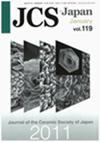Grain boundary segregation of Y and Hf dopants in α-Al<sub>2</sub>O<sub>3</sub>: A Monte Carlo simulation with artificial-neural-network potential and density-functional-theory calculation
IF 1.1
4区 材料科学
Q3 MATERIALS SCIENCE, CERAMICS
引用次数: 0
Abstract
Artificial-neural-network (ANN) interatomic potentials for Al–Y–O and Al–Hf–O systems are constructed using density-function-theory (DFT) data and combined with Monte Carlo (MC) simulations in order to predict Y and Hf segregation behavior at the ∑7(4510)/[0001] grain boundary (GB) in α-Al2O3. The ANN potentials are demonstrated to accurately predict preferential substitutional sites of not only an isolated but also multiple dopant ions. This enables us to circumvent DFT calculations for MC trial moves, thereby greatly reducing computational cost. There is a tendency that both Y and Hf ions substitute for 6-fold Al ions with elongated Al–O bonds at the GB and have coordination numbers greater than 6 after structural relaxation. This may suggest that even at the GB, Y and Hf ions prefer atomic environments in Y- and Hf-containing oxides with 7- and 8-fold coordination. Furthermore, effects of dopant species and concentrations on band-gap reduction at the GB are elucidated by analyzing partial density of states for the dopant-segregated GBs. The ANN-MC method with DFT analysis will pave the way for systematically determining atomic and electronic structures of GBs involving dopants, as demonstrated in this work.α-Al<sub>2</sub>O<sub>3</sub>中Y和Hf掺杂剂的晶界偏析:用人工神经网络电位和密度泛函理论计算的Monte Carlo模拟
利用密度泛函理论(DFT)数据,结合蒙特卡罗(MC)模拟,构建了Al-Y-O和Al-Hf-O体系的人工神经网络(ANN)原子间势,以预测α-Al2O3在∑7(4510)/[0001]晶界(GB)处的Y和Hf偏析行为。结果表明,人工神经网络电位不仅可以准确地预测单个或多个掺杂离子的优先取代位点。这使我们能够规避DFT计算的MC试验移动,从而大大降低了计算成本。在结构弛豫后,Y和Hf离子均有取代6倍Al离子的趋势,其Al - o键延长,配位数大于6。这可能表明,即使在GB中,Y和Hf离子也更倾向于在含Y和含Hf的氧化物中具有7和8倍配位的原子环境。此外,通过分析掺杂剂分离后的GBs的态偏密度,阐明了掺杂剂种类和浓度对GBs带隙减小的影响。ANN-MC方法与DFT分析将为系统地确定涉及掺杂剂的gb的原子和电子结构铺平道路,如本工作所示。
本文章由计算机程序翻译,如有差异,请以英文原文为准。
求助全文
约1分钟内获得全文
求助全文
来源期刊

Journal of the Ceramic Society of Japan
工程技术-材料科学:硅酸盐
CiteScore
2.10
自引率
18.20%
发文量
170
审稿时长
2 months
期刊介绍:
The Journal of the Ceramic Society of Japan (JCS-Japan) publishes original experimental and theoretical researches and reviews on ceramic science, ceramic materials, and related fields, including composites and hybrids. JCS-Japan welcomes manuscripts on both fundamental and applied researches.
 求助内容:
求助内容: 应助结果提醒方式:
应助结果提醒方式:


